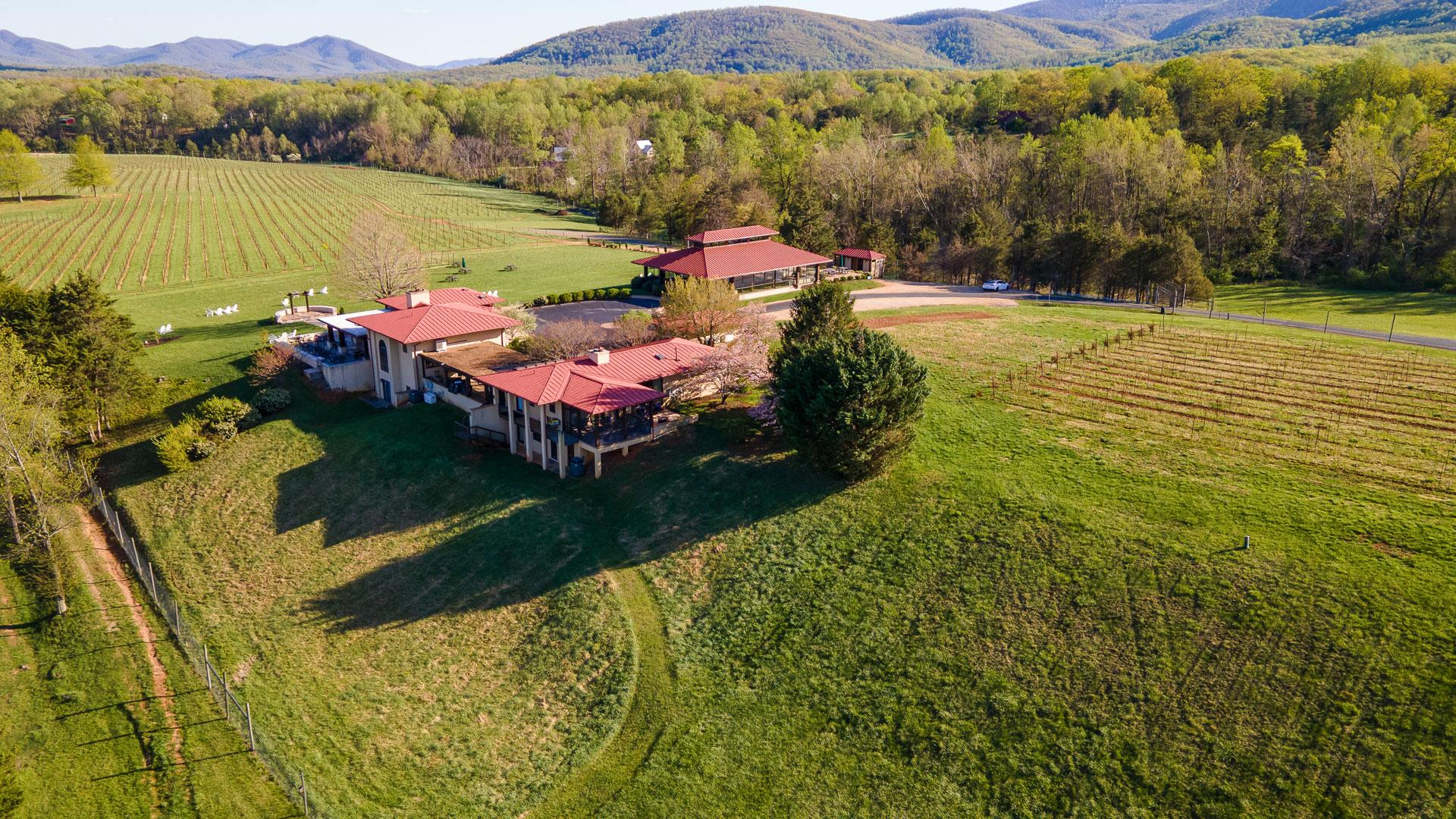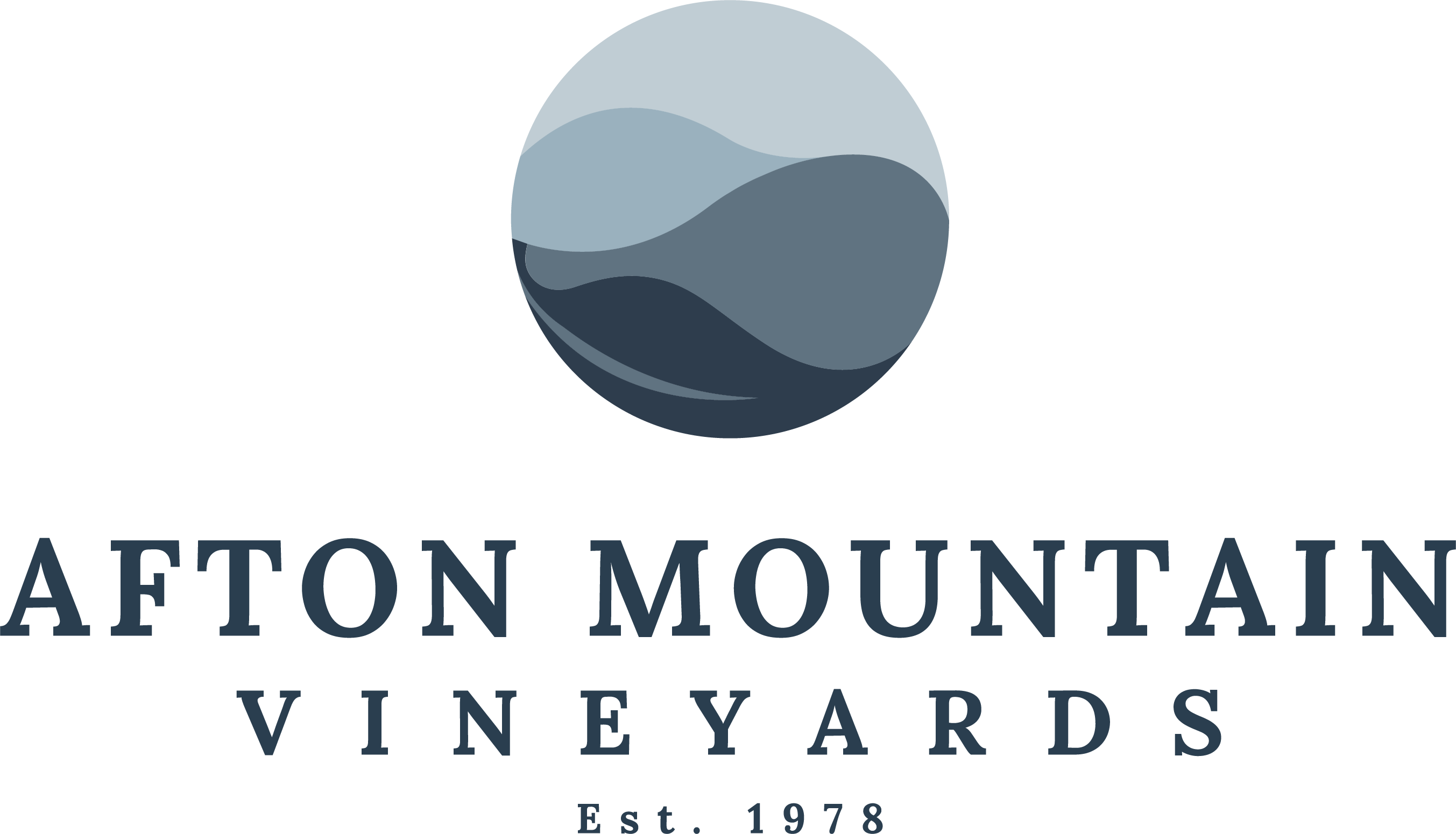Blog
Blog

When you sip a glass of Virginia wine while gazing at the Blue Ridge Mountains, you're experiencing the culmination of passionate craftsmanship, regional terroir, and centuries of winemaking evolution.
Nestled in the heart of Virginia wine country, the Monticello Wine Trail has emerged as a notable region producing exceptional red, white, rosé, and sparkling wines. But what exactly goes into creating these beloved bottles? And what do all of those words mean? This insider's guide to the terminology and processes used by winemakers will help you understand and enhance your next vineyard visit as you deepen your appreciation for the craft behind every pour.
The Vineyard: Where It All Begins
Terroir
Perhaps the most fundamental concept in winemaking, terroir refers to the complete natural environment in which wine is produced—including factors like soil composition, climate, topography, and even sunlight exposure. Afton Mountain Vineyards was one of the first to recognize the area’s unique terroir, characterized by its mineral-rich soil and protected mountain climate. Both of these contribute to the distinctive personality of wines from this region.
Canopy Management
When you see vineyard workers meticulously tending to grapevines, they're likely engaged in canopy management—the art of manipulating vine growth to optimize grape quality. By carefully pruning, training, and positioning vine shoots and leaves, winemakers control how much sunlight reaches the fruit, affecting everything from ripening rates to flavor development.
Veraison
Take a summer tour through Afton vineyards and you might hear winemakers excitedly discussing veraison (ver-Ray-zon)—the onset of ripening when grapes begin changing color from green to purple for red varietals or from green to yellow-gold for white wines. This crucial phase signals the beginning of sugar accumulation and flavor compound development in the grapes.
Hand Harvesting
While some large-scale vineyards use mechanical harvesting, many quality-focused wineries along the Nelson 151 Craft Beverage Trail insist on hand harvesting. This labor-intensive process allows for selective picking, ensuring only the best grapes make it into production while minimizing damage to both the fruit and vines.
From Grape to Must: Initial Processing
Crushing and Destemming
After harvesting, red grapes typically undergo crushing and destemming, where the fruit is gently broken to release juice while removing stems that could impart bitter flavors. For white and sparkling wines, whole-cluster pressing is often preferred. This process of forgoes the crushing and destemming and often produces a more delicate wine.
Cold Soaking
Many Virginia Wine Country red wine producers employ a technique called cold soaking, where crushed grapes are held at low temperatures before fermentation begins. This pre-fermentation maceration extracts aroma and flavor compounds from grape skins.
Pressing
For white wines, pressing happens immediately after harvest to separate juice from skins before fermentation. For reds, pressing typically occurs after fermentation to separate the newly made wine from the solid grape material (pomace). The gentle pressure applied during this process significantly impacts the final wine's character—too much can extract bitter compounds.
Fermentation: The Magical Transformation
Primary Fermentation
The heart of winemaking, primary fermentation is where yeast converts grape sugar into alcohol and carbon dioxide, transforming grape juice into wine. This important yet short step typically lasts 3-5 days. Winemakers carefully monitor temperature during this process—cooler fermentations (common for whites) preserve delicate aromas, while warmer fermentations (typical for reds) promote extraction of color and tannin.
Malolactic Fermentation
Often abbreviated as "MLF," this secondary fermentation converts sharp-tasting malic acid (think green apple tartness) into softer lactic acid (think dairy creaminess). Nearly all red wines and some whites (particularly Chardonnay) undergo this process, which contributes to a smoother, rounder mouthfeel in the finished wine.
Sur Lie Aging
Some Central Virginia white wine producers practice sur lie aging—leaving wine in contact with the "lees" (dead yeast cells) after fermentation. This technique adds complexity, texture, and subtle bread-like aromas to wines like Chardonnay and can include periodic "bâtonnage" (stirring) to enhance these effects.
Maturation: Developing Complexity
Barrel Aging
Walking through any Virginia winery cellar, you'll see rows of oak barrels where wines slowly mature. Oak barrel aging imparts additional flavors (vanilla, spice, toast) while allowing minute oxygen exposure that softens tannins and integrates flavors. The source of the oak (French vs. American), the size of the barrel, and whether it's new or previously used all influence the wine's development.
Fining and Filtration
Before bottling, most wines undergo some degree of clarification. Fining uses agents like bentonite clay or egg whites to remove unwanted particles and compounds, while filtration physically removes remaining sediment. Some Afton winemakers pride themselves on minimal intervention, producing "unfined and unfiltered" wines that preserve maximum flavor intensity.
Assemblage/Blending
The art of combining different varietals, vineyard lots, or barrel selections to create a harmonious final product. Skilled winemakers use blending to achieve greater complexity and balance than any single component could offer alone. Examples of blended wines include Afton Mountain Vineyards Library.
Specialized Wine Styles
Méthode Champenoise
Virginia's cool climate is ideal for sparkling wine production, and many wineries produce bubblies using the traditional méthode champenoise (also called méthode traditionnelle). This labor-intensive process involves a secondary fermentation in the bottle, followed by extended aging on the lees, riddling (gradually tilting bottles to collect sediment in the neck), and disgorging (removing the collected sediment). Afton Mountain Vineyards uses a hand bottling method for their bubbly wine.
Saignée Method
To produce some of Virginia's distinctive rosé wines, winemakers use the saignée ("bleeding") method, where juice is drawn off red grape skins after limited contact. This creates a pink wine with delicate fruit flavors while simultaneously concentrating the remaining red wine. The timing of the "bleed" determines the depth of color and flavor intensity.
Late Harvest
Taking advantage of Virginia's extended growing season, some Afton winemakers produce late harvest wines from grapes left on the vine longer than usual. This extended hang time results in higher sugar concentration and complex flavor development, yielding dessert wines of exceptional richness.
Finishing Touches
Bottle Aging
While many wines are released relatively young, premium reds and some whites benefit from additional aging in the bottle before release. During this time, harsh edges soften, and primary fruit flavors evolve into more complex secondary and tertiary aromas—adding layers of nuance to the final product.
Dosage
In sparkling wine production, dosage refers to the addition of a small amount of sweetened wine to the bottle after disgorging and before final corking. The amount of dosage determines whether the sparkling wine will be classified as Brut Nature (no added sugar), Extra Brut, Brut, Extra Dry, Sec, Demi-Sec, or Doux (sweetest).
Appellation
You'll often see "Monticello AVA" on bottles from Afton wineries, referring to their American Viticultural Area designation. This federally recognized growing region encompasses Albemarle and Nelson counties and signifies that the wine reflects the distinct characteristics of this geography. Winemakers must follow specific regulations to include this designation on their labels.
